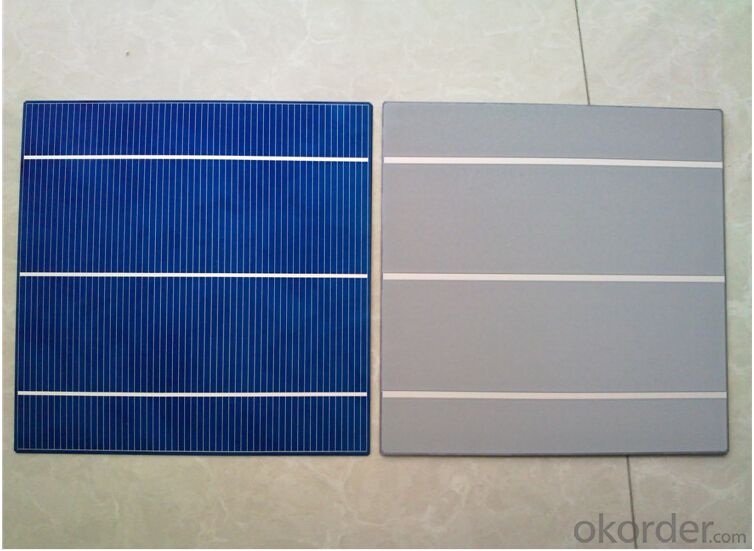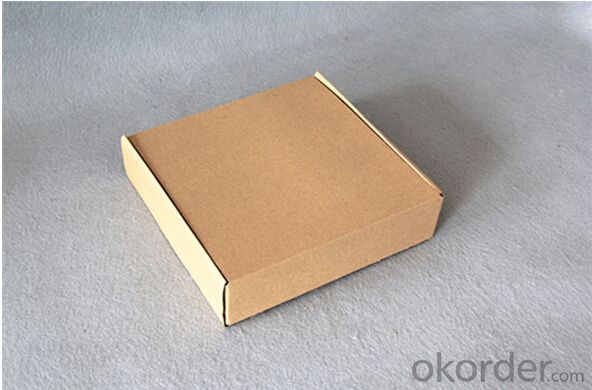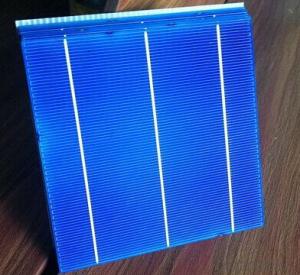Polycrystalline Solar Cells A GRADE 3BB 156*156mm with Low Price
- Loading Port:
- Shanghai
- Payment Terms:
- TT or LC
- Min Order Qty:
- 5000 pc
- Supply Capability:
- 8000000 pc/month
OKorder Service Pledge
OKorder Financial Service
You Might Also Like
Polycrystalline Silicon Solar Cells:
Solar cells is made by solar wafer, it has three categories of solar cell right now, monocrystalline polycrystalline and thin film,These cells are entirely based around the concept of ap-n junction, which is the critical part of solar module, it is the part that can convert the light energy into electricity, the thickness is from 180um to 200um, with even busbars to conduct electricity, textured cell can decrease diffuse reflection; they are often electrically connected and encapsulated as a module. Photovoltaic modules often have a sheet of glass on the front (sun up) side, allowing light to pass while protecting semiconductor wafers from abrasion and impact due to wind-driven debris, rain, hail, etc. Solar cells are also usually connected in series in modules, creating an additive voltage. Connecting cells in parallel will yield a higher current;With high quality and stable quality. Our Cells can greatly improve the performance of Solar Modules.
Polycrystalline Silicon Solar Cells Advantage:
• High efficiency and stable performance in photovoltaic conversion.
• Advanced diffusion technique ensuring the homogeneity of energy conversion efficiency of the cell.
• Advanced PECVD film forming, providing a dark blue silicon nitride anti-reflection film of homogenous color and attractive appearance.
• High quality metal paste for back surface and electrode, ensuring good conductivity, high pulling strength and ease of soldering.
• High precision patterning using screen printing, ensuring accurate busbar location for ease with automatic soldering a laser cutting.
Physical characteristics
Dimension: 156*156mm±0.5mm
Thickness: wafer(si): 200μm±20μm
Cell: 240μm±40μm
Front: silver bus bars;dark blue/others silicon nitride anti reflection coating
Back: silver/aluminum bus bars;full-surface aluminum BSF
Specification:
Mechanical data and design |
Format - 156 mm × 156 mm ± 0.5 mm |
Thickness- - 200 μm ± 20 μm |
Front (-) - 1.4 mm bus bars (silver),blue anti-reflection coating (silicon nitride) |
Back (+) - 2 mm wide soldering pads (silver) back surface field (aluminium) |
Temperature Coefficient of Cells |
Voc. Temp .coef.%/K -0.364%/K |
Isc . Temp .coef.%/K +0.077%/K |
Pm. Temp. coef.%/K -0.368%/K |
Efficiency code | Efficiency(%) | Pmax(w) | Impp(A) | Vmpp(V) | Isc(A) | Voc(V) |
182 | ≥18.20 | 4.43 | 8.26 | 0.536 | 8.71 | 0.634 |
180 | 18.0-18.2 | 4.38 | 8.22 | 0.533 | 8.68 | 0.632 |
178 | 17.8-18.0 | 4.33 | 8.17 | 0.530 | 8.63 | 0.630 |
176 | 17.6-17.8 | 4.28 | 8.12 | 0.527 | 8.60 | 0.627 |
174 | 17.4-17.6 | 4.23 | 8.08 | 0.524 | 8.56 | 0.625 |
172 | 17.2-17.4 | 4.19 | 8.05 | 0.521 | 8.53 | 0.622 |
170 | 17.0-17.2 | 4.14 | 7.99 | 0.518 | 8.49 | 0.620 |
168 | 16.8-17.0 | 4.09 | 7.94 | 0.515 | 8.45 | 0.618 |
Intensity Dependence |
Intensity [W/m2] Isc× [mA] Voc× [mV] Pmpp |
1000 1.00 1.000 1.00 |
900 0.90 1.000 0.90 |
800 0.80 0.99 0.80 |
500 0.50 0.96 0.49 |
300 0.30 0.93 0.29 |
200 0.20 0.92 0.19 |
IV Curve

Solar Panel Images:


Packaging & Delivery of Polycrystalline Solar Cells
Carton Box Package and Deliver by air. It should be noticed that it should be avoid of water, sunshine and moist.
FAQ
We have organized several common questions for our clients,may help you sincerely:
①What price for each watt?
It depends on the efficiency of the solar cell, quantity, delivery date and payment terms.
②How long can we receive the product after purchase?
In the purchase of product within three working days, We will arrange the factory delivery as soon as possible. The pecific time of receiving is related to the state and position of customers.Commonly 7 to 10 working days can be served.
③Can you provide the peripheral products of the solar panels, such as the battery, controller, and inverter? If so, can you tell me how do they match each other?
Yes, we can, we have two companies for solar region, one is CNBM International, the other is CNBM engineering Co.
We can provide you not only the solar module but also the off grid solar system, we can also provide you service with on grid plant.
④What is your warranty of solar cell?
Our product can promise lower than 0.3% open box crack, we support claim after opening the box if it has crackm color difference or sth, the buyer should give pictures immediately, we can not accept the claim after the solar cell has assembled to solar panel.
• Timeliness of delivery
• ⑤How do you pack your products?
We have rich experience on how to pack the solar cell to make sure the safety on shipment, we could use wooden box or pallet as buyer's preference.
⑥ Can you do OEM for us?
Yes, we can.
Solar power has been able respected, more and more widely used, in large part because it is environmentally friendly way of generating renewable power generation process does not produce carbon dioxide and other greenhouse gases, will not pollute the environment, and therefore widely. From the current terms of the types of solar cells, including crystalline silicon cells, thin film batteries and other battery materials. Monocrystalline silicon cells are divided into cells, polycrystalline cells and amorphous silicon thin-film batteries.
For solar cells, the most important parameter is the photoelectric conversion efficiency, developed in the laboratory of silicon-based solar cells, Monocrystalline silicon cell efficiency of 25.0%, polycrystalline silicon cell efficiency of 20.4%, CIGS thin-film cell efficiency of 19.6%, CdTe thin film cell efficiency of 16.7%, an amorphous silicon (amorphous silicon) thin film battery efficiency of 10.1%, while in practical application efficiency is slightly lower this level.
We are familiar with crystalline silicon cells into single crystal and polycrystalline, except that the silicon wafers. Monocrystalline wafers made of polysilicon raw material crystal pullers pull into a bar and then sliced into monocrystalline, polycrystalline silicon film is made of polysilicon through ingot casting furnaces made of polysilicon ingots and then sliced. Since the difference between the fabrications of polycrystalline silicon solar cell battery much. But the conversion rate, the current conversion rate of monocrystalline silicon cells generally 16% to 18% conversion rate of polycrystalline silicon cells generally 15% to 16%. From the comparison of production costs, polycrystalline silicon cells cheaper materials manufacturing simple, to save power consumption, lower overall production costs, get a lot of development. Therefore, polycrystalline silicon cells accounted for two-thirds of the amount of crystalline silicon cells, accounting for over 55% of the solar cell market share. However, although the cost of polysilicon occupies advantage, in addition to the conversion rate lower than the silicon, its service life is shorter than the Monocrystalline silicon solar cells.
- Q:Can solar cells be used to power remote agricultural monitoring systems?
- Yes, solar cells can be used to power remote agricultural monitoring systems. Solar cells convert sunlight into electricity, providing a sustainable and renewable energy source for powering various electronic devices, including monitoring systems used in agriculture. This enables the monitoring systems to operate independently in remote areas without the need for a constant power supply or grid connection.
- Q:What should I know about the Crystalline silicon photovoltaic cells?
- Crystalline silicon photovoltaic cells, known as cSi PV, are made of silicon atoms connected to one another to form a crystal lattice. This lattice comprises the solid material that forms the photovoltaic (PV) cell's semiconductors.
- Q:How many solar cells are there in a solar panel?
- I need to know the power of the solar panel to answer the question.
- Q:Can the solar powered cells really work better than the normal cells?
- There is no doubt that the solar powered cells work better than the normal cells, the only disadvantage is the cost of making it.
- Q:Can solar cells be damaged by hail or other weather conditions?
- Yes, solar cells can be damaged by hail or other severe weather conditions. Hail can cause physical damage to the surface of solar cells, such as cracks or breakage, which can reduce their efficiency or render them completely non-functional. Additionally, extreme weather conditions like hurricanes or strong winds can also dislodge or damage solar panels, impacting their performance. Therefore, it is essential to consider the durability and resilience of solar panels when installing them in areas prone to severe weather.
- Q:How are solar cells connected in a photovoltaic system?
- Solar cells are connected in a photovoltaic system in series or parallel configurations to generate the desired voltage and current output.
- Q:What is the impact of partial shading on solar cell performance?
- Partial shading on solar cell performance can have a significant negative impact. When a solar cell is partially shaded, even a small portion of shading can reduce its overall power output. This is because shaded cells create voltage mismatches within the solar panel, leading to decreased current flow and overall efficiency. Additionally, partial shading can also cause hotspots, which can damage the solar cells and reduce their lifespan. Therefore, it is crucial to design solar systems carefully, avoiding any shading to ensure optimal performance and maximize energy generation.
- Q:What is the lifespan of solar cells?
- The lifespan of solar cells can vary depending on various factors such as the type and quality of the cells, their usage and maintenance, and the overall conditions they are exposed to. However, on average, solar cells have a lifespan of around 25 to 30 years.
- Q:How do solar cells affect air pollution?
- Solar cells help reduce air pollution by producing electricity without emitting harmful pollutants or greenhouse gases. Traditional energy sources such as coal, oil, and gas power plants release pollutants like sulfur dioxide, nitrogen oxide, and carbon dioxide, contributing to air pollution and climate change. Solar cells, on the other hand, convert sunlight directly into electricity, generating clean and renewable energy. This reduces the need for fossil fuel-based electricity generation, thereby reducing air pollution and improving air quality.
- Q:How do solar cells impact energy security?
- Solar cells have a positive impact on energy security as they provide a reliable and sustainable source of electricity. By harnessing the power of the sun, solar cells reduce dependence on finite fossil fuels, increasing energy independence and reducing the risks associated with fluctuating fuel prices and geopolitical conflicts. Additionally, solar energy can be generated locally, reducing the vulnerability of energy supply chains and enhancing resilience in the face of natural disasters or other disruptions. Overall, solar cells play a crucial role in diversifying the energy mix and enhancing energy security for individuals, communities, and nations.
1. Manufacturer Overview |
|
|---|---|
| Location | |
| Year Established | |
| Annual Output Value | |
| Main Markets | |
| Company Certifications | |
2. Manufacturer Certificates |
|
|---|---|
| a) Certification Name | |
| Range | |
| Reference | |
| Validity Period | |
3. Manufacturer Capability |
|
|---|---|
| a)Trade Capacity | |
| Nearest Port | |
| Export Percentage | |
| No.of Employees in Trade Department | |
| Language Spoken: | |
| b)Factory Information | |
| Factory Size: | |
| No. of Production Lines | |
| Contract Manufacturing | |
| Product Price Range | |
Send your message to us
Polycrystalline Solar Cells A GRADE 3BB 156*156mm with Low Price
- Loading Port:
- Shanghai
- Payment Terms:
- TT or LC
- Min Order Qty:
- 5000 pc
- Supply Capability:
- 8000000 pc/month
OKorder Service Pledge
OKorder Financial Service
Similar products
New products
Hot products
Hot Searches
Related keywords



























